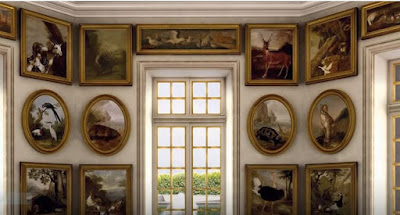The minority of Louis XV inevitably brought neglect. Peter the Great paid a visit in 1717 accompanied by the maréchal de Tesse and duc d'Antin. He found the birds already sadly depleted since days of Louis XIV. At about this time too the land adjoining the Menagerie was put into cultivation. The Regent sold some animals and gave others away. The return of the Court to Versailles in 1722 did little to reverse the decline. Louis is not recorded as ever having visited. He accepted gifts of spectacular animals readily enough but preferred to receive them in the salon de Mercure inside the chateau itself. The reign of Louis XVI at first brought little change as the Court continued to eschew the formal spaces of Versailles for Paris or for private retreats..Under Marie Antoinette it was the Trianon, with its small menagerie of domestic animals, that became the focus of royal sociability.There is no mention of the Menagerie in the Queen's correspondence and it did not feature at all a map of Versailles made in 1781 indicating paths to be maintained for the royal family's promenades.
As a result, the Menagerie was left more and more in the hands of its staff. By 1750 lack of investment had reduced it to a dilapidated state - buildings deteriorated and yards turned into a quagmire when the water system flooded. The comte d'Angiviller, who became surintendant des Bâtiments du Roi at the death of Louis XV, tried to save it. In October 1771 he wrote a memoir on its condition, visited it himself and instructed the Park inspector Lécuyer to restore the courtyard which had been given over to cultivation. Nonetheless, by the end of 1783 it was reported that the animal houses were falling down and the pavilion itself in a bad state of disrepair, with the famous animal paintings no longer recognisable. It was only in 1785-6 that renovations were finally begun in earnest.
Since at least the 1690s the Menagerie had been open to public view. Despite competition from private menageries and from the exotic animals displayed in the fairs of St Germain or St Laurent, the new fad for natural history from the mid-century ensured interest was buoyant - up to fifty carriages a day made the journey from the capital in the 1750s. There was still the occasional illustrious visitor, Joseph II appeared incognito in 1777 among a crowd of Breton visitors and in 1782 the animals were admired by the Duke and Duchess of Russia.
The animals
Large animals were both difficult to source and complex to transport long distances. It was only after the Seven Years War that the Compagnie des Indes was able to furnish animals in any numbers. Nonetheless the acquisition of specimens took place sporadically throughout the period. Between 1729 and 1749 Maurepas managed to procure three lions, a tiger and a Barbary sheep. Other animals appear in the sources, with no details of their provenance. For example duc de Luynes, who was a regular visitor, mentions a dromedary in 1750, a lion and another camel in 1751. In the 1770s the duc de Croy refers to a seal that had been brought from Dalmatia. The director Laimant is recorded as buying provisions for bears and monkeys in the 1780s, and also repairing a house inhabited by a mongoose. In 1765 Louis XV paid the enormous expenses of transporting a tiger from India and two others were acquired in 1770 - four hundred sheep were required to feed the animals during the voyage between Chandernagore and Lorient. They were followed by a rhinoceros in 1770 and in 1772 an elephant, which entertained the crowds by opening wine bottles with its trunk. (The unfortunate animal drowned in its polluted pool in 1782). Louis XVI sent out a list of further animals he wished to acquire including an elephant, two zebras (one male and one female), baboons and six guinea-fouls; but sadly only a single zebra was ever delivered.
A list of animals can be found in Gustave Loisel's 1912 book, page 170-183.
References
Gérard Mabille and Joan Pieragnoli, La ménagerie de Versailles Eds Honoré Clair 2010 (extracts)
http://issuu.com/aristeas/docs/menagerie_extrait/0
Peter Langdon "Strange Meetings: The Royal Menagerie at Versailles" Culture and Stuff [blog] 15 August 2011
http://cultureandstuff.com/2011/08/15/strange-meetings-the-royal-menagerie-at-versailles/
Gustave Loisel Histoire des ménageries de l'Antiquité à nos jours, vol.2 (1912) p.135-57.
https://archive.org/stream/histoiredesmna02loisuoft#page/135/mode/2up
Last building of the Menagerie of Versailles - Virtual Tourist site http://members.virtualtourist.com/m/p/m/240288



No comments:
Post a Comment